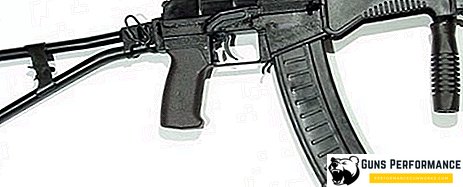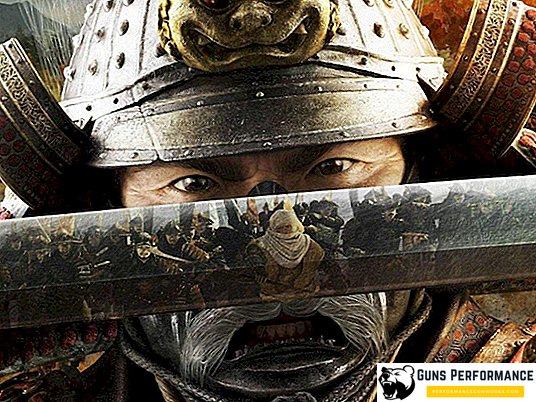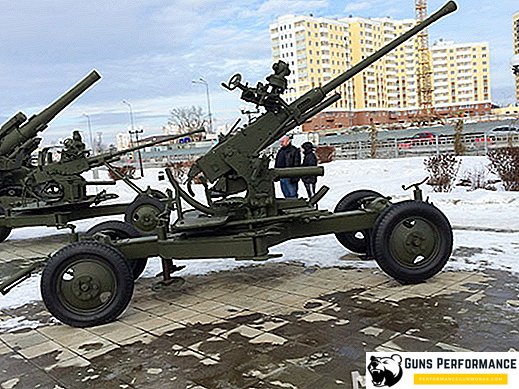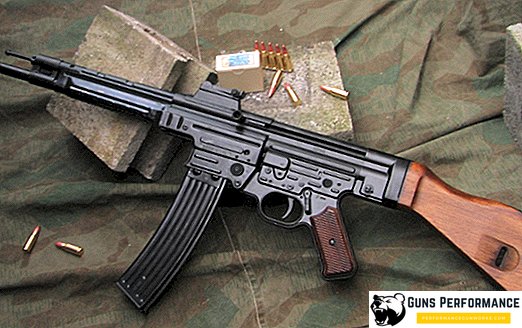
Su-17 is a Soviet jet fighter-bomber, created in the mid-60s and for several decades was in service with the USSR Air Force. The Su-17 is the first aircraft with variable wing geometry developed in the USSR.
Su-17 was used in a variety of local conflicts of the 70-80s, participated in the Afghan war, in large quantities, this aircraft was exported. The most massive export modifications of this machine are the Su-20 and Su-22.
Production of the fighter-bomber continued until 1990. In total, more than 2,800 units of this combat vehicle were manufactured. The Su-17 is still in service with the air forces of Poland, Vietnam, Angola, Syria, Uzbekistan and Libya.

The history of the Su-17
In 1960, the Su-7 fighter-bomber, which had very high characteristics for its time, was adopted by the Soviet army. However, the military did not like his landing speed, there were other comments on the design of the aircraft, its electronics and weapons.
Therefore, in the early 60s, the designers of the Sukhoi Design Bureau were tasked with modernizing the new machine. In those years, the concept of aircraft with variable swept wing was considered one of the most promising, so it is not surprising that it was decided to use it to improve the characteristics of a fighter-bomber.
The TsAGI specialists, together with the designers of the Sukhoi Design Bureau, proposed an original wing design for the new aircraft: the angle was changed only by its console part (about half the span). Thanks to this design, there was practically no need to change the fuselage of the original car (Su-7). The size of the center section was determined by the location of the main landing gear of the aircraft. In addition, this technical solution practically did not lead to a change in the centering of the machine when the wing was changed, the aircraft showed good stability at all sweep angles in a wide range of speeds.
The new fighter-bomber received the designation MS-19, work on its creation started in 1965. The prototype for the new machine was the fighter-bomber Su-7BM. The chief designer of the new project was Zyrin. Engineers needed to develop a swivel console and hinge, as well as to strengthen the design of the center section of the aircraft and create a synchronization mechanism for the two parts of the wing.

Additional structural elements made the aircraft 400 kg heavier.
During the design work, it was decided to use the mechanization of the leading edge of the wing (except the flaps) on the new machine.
At the end of 1965, the drawings of the fighter-bomber were transferred to production. August 2, 1966 a new aircraft took off. During the flight, the pilot several times shifted the wing. The successful course of testing allowed to show the new aircraft in the air parade in Tushino in July 1967. In November of the same year, the USSR Council of Ministers issued a decree on the start of mass production of the new machine in 1969. She received the name of the Su-17.
Serial production of the Su-17 began at an aircraft factory in Komsomolsk-on-Amur, before that they produced the Su-7. The first subdivision into which the Su-17 began to enter was the 523rd Aviation Regiment of the Far Eastern Military District.
Su-17 showed the best flight performance compared with its prototype Su-7BM. The new fighter-bomber had a long range and its duration, despite the reduced volume of fuel tanks and an increase in vehicle mass, and its take-off and landing characteristics improved. Also, significant changes were made on-board electronic equipment of the aircraft.

If we talk about the Su-17 project as a whole, then it should be noted a simple and inexpensive technical solution, which significantly improved the flight characteristics of an existing vehicle. It also made it easy, quick and cheap to start mass production of the new aircraft at the plant, which previously produced the Su-7.
Modernization expanded tactical capabilities of the aircraft, as well as increased the range of its use. However, the increase in mass of the Su-17 almost nullified all the improvements achieved on the experimental machines.
Description of the design of the Su-17
The Su-17 fighter-bomber is an all-metal monoplane, made according to the classical aerodynamic configuration with an average wing layout. The aircraft is equipped with a single engine, has a chassis with three racks and a wing that can change its sweep in the range from 30 to 63 °. The car is piloted by one pilot.

Su-17 is designed to destroy ground, air and surface targets, as well as for reconnaissance.
Glider machine is made of aluminum alloys. The cockpit is in front of the aircraft, it is closed by a lantern that opens back-up. A special periscope is installed in the cockpit lantern, with which the pilot can observe the rear hemisphere. Su-17 was equipped with ejection seats (first KS-4S-32, and in later versions - K-36DM).
Su-17 chassis - three-post, with a single balloon on all wheels. To reduce the length of the run, the Su-17 is equipped with a braking parachute.
Various modifications of the fighter-bomber differed in their onboard equipment. The Su-17MZ (one of the most massive modifications) was set up with the KN-23 sighting and navigation system, consisting of a Klen-PS laser rangefinder, ASP-17BTs-8 shooting and bomber target, and a radio height meter RV-5.

A turbojet engine with an afterburner (TRDF) was installed on the Su-17: the AL-21F3 or R-29BS-300.
Airplanes of all modifications of the Su-17 were armed with two 30-mm guns NR-30, which were installed in the center section. There were also six pylons for the suspension of rocket-bomb armament: two under the wings, and four under the fuselage. Modification of the Su-17M4 had ten pylons for the suspension of rockets and bombs. Her combat load was 4250 kg.
Modifications of the Su-17 and Su-17M had a PBC-2 bomb mount and a ASP-5ND-7 riflescope. A more modern ASP-17 rifle scope was installed on the Su-17M2.

Su-17 combat use
The first Su-17 began to arrive in the USSR Air Force units in 1972. In the same period, the export of the aircraft began. In 1970-1971 the designers of the Sukhoi Design Bureau developed an export version of the car, the Su-20, which in 1972 began to be shipped to Egypt. The design of the Su-20 was almost similar to the Su-17M, there were small differences in the on-board equipment and aircraft armament system.
In 1973, the development of another export modification of the car began - Su-22. Su-22 received a new R-29BS-300 engine and R-3C and X-23 missiles.

The first cars of the Su-22 were received by the Air Force of Peru.
From 1973 to 1990 about seven hundred aircraft of the Su-20 and Su-22 modification were manufactured. They were in service with the allied countries of the Soviet Union under the Warsaw Pact, as well as the states that the USSR provided military assistance at different times.
Su-17 and its export modifications Su-20 and Su-22 theoretically had the opportunity to conduct air combat against third-generation western fighters, but as such these machines were almost never used. The Su-20 was first used during the 1973 Arab-Israeli conflict. This aircraft was in service with the Syrian and Egyptian air forces. Su-20 attacked Israeli military and industrial sites. During the fighting, 12 Su-20s were lost.
The second campaign, which used the Su-17 (this time the modification of the Su-22) was the war in Lebanon in 1983. Its use was very unfortunate: in the course of one combat departure (ten aircraft), seven cars were shot down.
The Su-17 was very actively used during the Afghan war, it became the only Soviet aircraft that went through this campaign from start to finish. Su-17 was used as a bomber, attack aircraft and reconnaissance aircraft. In addition, this machine in the modifications of the Su-20 and Su-22 became the basis of the Afghan Air Force. During this conflict, about thirty cars were lost (no exact data). Several aircraft of export modifications (Su-20 and Su-22) were shot down by Pakistani air force fighters. One Su-22 was hijacked by an Afghan pilot to Pakistan. Several Su-22 fell into the hands of the Taliban after they seized power in the country. Later, all Taliban aircraft were destroyed by the Americans at airfields.
Su-20 and Su-22 were the main machine of the Iraqi air force during the Iran-Iraq war. The total loss of these aircraft during this campaign is more than sixty cars.
During the first Gulf War, Iraq overtook 44 Su-20s to Iran to protect them from the attacks of the international coalition. After the war, the Iranian authorities refused to give the aircraft to their rightful owner.
The Su-17 was used by the Angolan air force during the civil conflict against the partisans of UNITA.
Libyan air forces used these machines to attack the forces of the rebels at the initial stage of the civil war.
Yemeni Air Force used the Su-17 against Shiite rebels.
Currently, the Syrian air force is using the Su-17 to deliver rocket-bombing attacks on the positions of the rebels. At least five lost cars are known. In early September 2018, the Su-22M4 Syrian Air Force was shot down in the area of the village of Deir-ez-Zor. The pilot died.

Technical characteristics of SU-17 1970 release
- Years of production: 1969-1990.
- Total manufactured: 2867 pcs.
- Combat use: military conflicts of the second half of the twentieth century.
- Crew - 1 person.
- Take-off weight - 16.2 tons.
- Dimensions: length - 18 m, height - 4.9 m, wingspan with a sweep of 30 degrees - 13.6 m, with a sweep of 63 degrees - 10 m.
- Armament: 2x30-mm cannons, ammunition - 160 shells, six suspension points to which air-to-air guided missiles are mounted, unguided rockets, and bombs
- Turbojet engine.
- The maximum speed is 1350 km / h.
- Practical ceiling - 16.3 km.
- Flight range - 1930 km.













